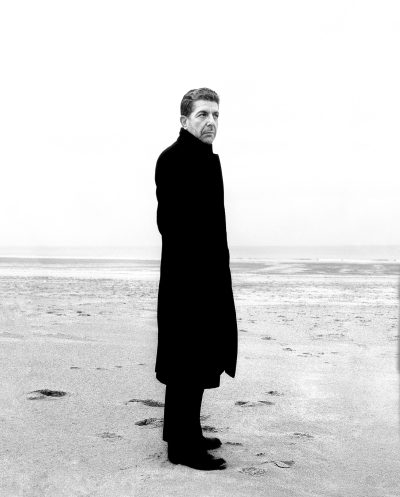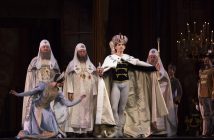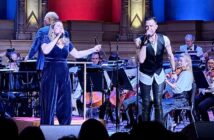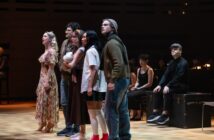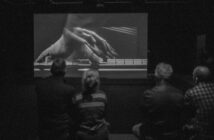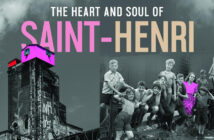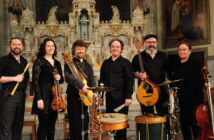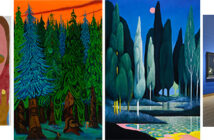Leonard Cohen: A Crack in Everything – Like an aurora of dreams, quirks, and visions, this major art exhibition at the Musée d’art contemporain de Montréal shimmers to a close on 9 April.
The brokenness of existence
Ring the bells that still can ring
Forget your perfect offering
There is a crack in everything
That’s how the light gets in
— “Anthem” (1992)
The Persian poet and Sufi mystic Rumi (1207–1273) wrote that “The wound is the place where the light enters you.”
The Canadian poet, novelist and singer-songwriter Leonard Cohen (1934–2016) wrote that “There is a crack in everything / That’s how the light gets in.”
The Argentinian poet, essayist and short story writer Jorge Luis Borges (1899–1986) wrote that all poets are really just one poet, a universal consciousness, a single mind. He believed that our earthly condition is necessarily broken and incomplete, and that our recognition of this state of being is a requirement of our potential enlightenment. He thought that this brokenness can give us a glimpse of and perhaps a path to that greater existence of which we are a part.
The brokenness of existence is Leonard Cohen’s theme. Incompletion perpetually striving towards completion. The agony and ecstasy of love. The silent indifference of God.
I’m ready, my lord
If you are the dealer, I’m out of the game
If you are the healer, it means I’m broken and lame
If thine is the glory then mine must be the shame
You want it darker
We kill the flame
Magnified, sanctified, be thy holy name
Vilified, crucified, in the human frame
A million candles burning for the help that never came
You want it darker
Hineni, hineni [Here I am, here I am]
I’m ready, my lord
— “You Want It Darker” (2016)
Humankind, in perpetual crisis, seeks purpose, meaning, gods. The art of song prevailed long before the pyramids. It drew breath at the birth of language, ritual, art, religion. It formed and fed primordial need.
Cohen began as a poet:
With Annie gone,
whose eyes to compare
with the morning sun?
Not that I did compare,
But I do compare
Now that she’s gone.
— “For Anne” (1961)
He published two experimental novels and several collections of poetry that addressed the bewilderments of flesh and spirit. A degree of critical but impecunious success followed. To pay his bills, he became a songwriter. His first album, Songs of Leonard Cohen (1967), won him a cult following, mainly in Europe:
And Jesus was a sailor
When he walked upon the water
And he spent a long time watching
From his lonely wooden tower
And when he knew for certain
Only drowning men could see him
He said “All men will be sailors then
Until the sea shall free them”
But he himself was broken
Long before the sky would open
Forsaken, almost human
He sank beneath your wisdom like a stone
— “Suzanne” (1967)
Other songs, albums, and books of poetry followed, some of them well-received, others falling dead-born from the presses. By 1978 he had become unmarketable. In 1984, his record company refused to issue his seventh album in America. This album, “Various Positions”, contained three masterpieces: “Hallelujah,” “Dance Me to the End of Love,” and “If It Be Your Will”.
In 1988, there was a Cohen revival. His eighth album “I’m Your Man” made him cool again. Other recordings, books of poetry, experiments and hiatuses followed. He became a Zen monk. In 2004 he discovered that his manager had cleaned out his bank accounts: his entire life savings of five million dollars. She refused to respond to subpoenas, and then disappeared. In 2008, at age 73, broke but unbroken, Cohen put together a crack nine-piece band and hit the road.
Just a kid with a crazy dream
Doubting his marketability after a 15-year absence from touring, Cohen began at a 700-seat venue in Fredericton, New Brunswick. The critical and audience response was more than completely unexpected: it was ecstatic. Prolonged standing ovations occurred at every tour stop. What followed was one of the greatest creative and performance codas in the history of music. He sold out major theatres and stadiums around the world. He headlined the UK’s most prestigious music festival, Glastonbury, playing to 100,000 people.
His marathon 2008-2010 and 2012-2013 world tours were like those evangelical events that fervent crowds throng in stadiums around the globe. In a 2013 review of a sold-out performance at London’s 20,000-capacity 02 Arena, Bernadette McNulty of The Telegraph wrote: “Seeing Cohen live is like going to see a finished masterpiece by an Old Master. His three-hour sets are the Sistine Chapel ceiling of live performance: their exquisite beauty renders you silent, sometimes tearful but always grateful to have been able to experience such radiance and majesty.”
In the last five years of his life, Cohen released three creatively outstanding and commercially successful studio albums: Old Ideas (2012), Popular Problems (2014), and You Want It Darker (2016). Starting with the masterful Live in London (2009), he also released four new live albums. Whether studio- or stage-born, all of his “late” albums topped the charts and won critical acclaim around the world.
An aversion to beauty
The Montreal painter and goth dandy Margaret van Dyck once said to me: “Canadians, as a people, have an aversion to beauty and a resentment of those who produce it. Poetry and art? Good god man, who do you think we are, Italians?”
Leonard Cohen began his career in his hometown of Montreal, at a time that Canadian art, music and poetry had no traction, and little visibility, either inside or outside the country. There was Glenn Gould. The Group of Seven. Margaret Atwood. Irving Layton. Mordecai Richler. Mavis Gallant. Alice Munro. A handful of others, including the French-Canadians Gabrielle Roy, Marie-Claire Blais, and Jean-Paul Riopelle.
Have you ever seen one of those old, grainy black and white films—typically photographed by anthropologists—of a half-extinct African tribe, gathered in the centre of a village, dancing, singing, chanting, reciting their history, beliefs, stories, poetry, “in the zone” of ecstatic oneness? It is this undividedness that we have lost in art and culture. Certain artists, poets, and composers attempt to restore this lost psychic unity. They create beauty and meaning out of chaos.
The American poet Randall Jarrell said: “I think that one possible definition of our modern culture is that it is one in which nine-tenths of our intellectuals can’t read any poetry.”
All art strives towards the condition of music. Fusing the erotic with the spiritual, Leonard Cohen created a sound- and word-world of his own. He combined song, myth, poetry, prose, speech, prayer, and liturgy into a dance-like art of story. We crack open his work to experience a tableau de son of mourning, fleeting joy, ecstasy, beautiful brokenness, and striving incompletion. It gives us a glimpse of and perhaps a path to that greater existence of which we are a part.
Leonard Cohen: A Crack in Everything
Like an aurora of dreams, quirks, and visions, this major art exhibition at the Musée d’art contemporain de Montréal shimmers to a close on 9 April. Almost three years in the making, it features primarily commissioned works which engage with Cohen’s legacy.
You’ll want to tiptoe into “Depression Chamber” by Israeli artist Ari Folman. Only one person can experience it at a time. You lie on a daybed and, with the help of capture technology, you see yourself projected on the ceiling. You hear Cohen’s most bleakly beautiful nocturnal ideation, “Famous Blue Raincoat” (1971). This song may be a Cain and Abel story, involving Cohen, a woman, and a male frenemy. Or it may be Cohen addressing his shadow, or dark side, concerning a woman:
And what can I tell you my brother, my killer
What can I possibly say?
I guess that I miss you, I guess I forgive you
I’m glad you stood in my way
Animated lyrics float by—letter by letter—and slowly morph into icons that flood the sarcophagus-like space. No drugs required in this experiential triumph.
A video retrospective of Leonard’s life and music, the 56-minute “Passing Through” by George Fok, unfolds in a large dark room dominated by wrap-around projection screens. A lifetime of Cohen performances, interviews, readings, and biographical material delight us here as much as they tell us why his songs remain evergreen.
A recreation of Leonard’s postage stamp work studio in his Los Angeles home defines the simplicity of his taste. A larger room features an installation of eighteen aged men and the choir of Leonard’s Montreal synagogue on film. They sing along to the album “I’m Your Man”. A film by Michael Rakowitz examines the 1973 Arab-Israeli war and Cohen’s attempt to give peace concerts in Tel Aviv and Ramallah in 2009. High up in the rafters, “Bird on a Wire,” one of Leonard’s signature songs, becomes a film of . . . a bird on a wire.
You’ll want to spend at least half a day exploring the 20 works by 40 artists from 10 countries in this unpredictable catalogue of curiosities.
The Sisters of Mercy
Well they lay down beside me, I made my confession to them.
They touched both my eyes and I touched the dew on their hem.
If your life is a leaf that the seasons tear off and condemn
They will bind you with love that is graceful and green as a stem.
— “The Sisters of Mercy” (1967)
Leonard Cohen was famous for his intense friendships and love affairs with women. He developed his feminine side to a high degree, embodying the masculine/feminine balance mandated by some of the religions and philosophies he studied throughout his life. Love, acceptance, humility, levity and gravity saturated Cohen’s singular persona. Genetics and spiritual discipline made him almost unfailingly kind, patient, generous, and compassionate to strangers and to everyone who knew him. Beyond the potency of his art, he was a rare creature who can serve as a model of comportment in our time.
Un sage était autrefois un philosophe, un poète, un musician. Ces talents ont dégénéré en se séparant. [In former times, a wise man was a philosopher, a poet, a musician. These gifts degenerate when separated.] —DIDEROT
Leonard Cohen: A Crack in Everything ends 9 April at the Musée d’art contemporain de Montréal, 185 Ste-Catherine St. W. For full program details and ticket information visit macm.org.


